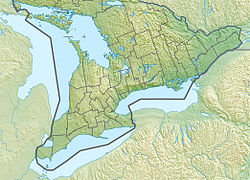| Ganaraska River | |
|---|---|
 The Ganaraska River flowing through Port Hope | |
| Etymology | from Ganaraske, the name for the Cayuga village at the river mouth |
| Location | |
| Country | Canada |
| Province | Ontario |
| Region | Southern Ontario |
| Districts | |
| Physical characteristics | |
| Source | Ganaraska Forest on the Oak Ridges Moraine |
| • location | Clarington, Regional Municipality of Durham |
| • coordinates | 44°03′15″N78°36′22″W / 44.05417°N 78.60611°W |
| • elevation | 344 m (1,129 ft) |
| Mouth | Lake Ontario |
• location | Port Hope, Northumberland County |
• coordinates | 43°56′30″N78°17′26″W / 43.94167°N 78.29056°W |
• elevation | 74 m (243 ft) |
| Basin size | 278 km2 (107 sq mi) |
| Basin features | |
| River system | Great Lakes Basin |
| Tributaries | |
| • left | North Ganaraska River |
The Ganaraska River is a river in Northumberland County and the Regional Municipality of Durham in Southern Ontario, Canada. [1] It is part of the Great Lakes Basin, and is a tributary of Lake Ontario, which it reaches at the central community of the municipality of Port Hope. The river's name is thought to be derived from Ganaraske , the Cayuga name for the village this Iroquoian nation had established in this area in 1779.
Contents
Together with other nations of the Iroquois Confederacy, they had migrated from New York, forced to cede their homelands because of having allied with the British in the American Revolutionary War. The Crown provided additional lands to the Iroquois peoples, including what is now called the Six Nations of the Grand River reserve.
Later the Crown granted land here to United Empire Loyalists, in compensation for their losses in the Northeast colonies, especially New York. They were the first European Americans to settle here in any number.

